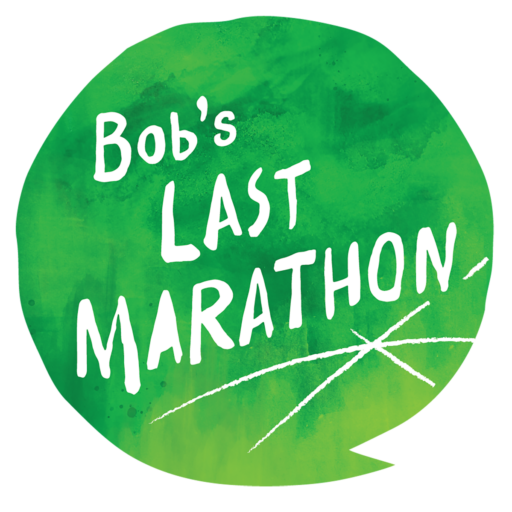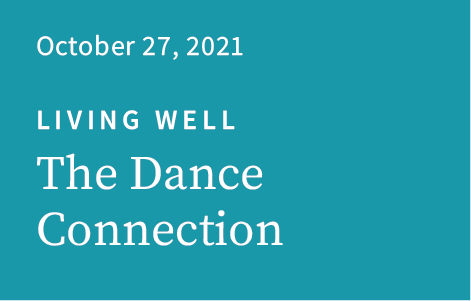Transcript
The Dance Connection
People often ask me: What is dance/movement therapy and how can it help my loved one with Alzheimer’s disease? I’ll start with an official definition from the American Dance Therapy Association, which describes dance/movement therapy as “the psychotherapeutic use of movement to promote emotional, social, cognitive and physical integration of the individual.” On its most basic level, dance is a way to connect through movement. Even eye contact and breathing involve movement, which gives individuals ways to connect with others, regardless of their cognitive or physical ability.
In my dance therapy sessions, I aim to meet people where they are. I work to establish a safe, creative environment for people to be heard and seen—a space that encourages expression, both verbally and non-verbally. I honor the individual’s unique strengths and abilities, offering options that take personal preferences into account. There’s no right or wrong! Through dance/movement therapy, people with dementia can tap into creativity and imagination—skills that can help them cope with their surroundings and adapt to changes and losses. The goals of a dance/movement therapy session vary from individual to individual, but might include reducing frustration, encouraging relaxation, and increasing focus.
Dance/movement therapy sessions are highly adaptable. They can happen one to one, or in small groups of about 10 to 12 people. There are no special space requirements—I’ve held sessions in therapeutic dayrooms, wellness centers, rehabilitative care settings, community centers, outdoor spaces, and on virtual platforms. I encourage people to participate at their own level of comfort, preference, and ability. Sessions typically last 30 minutes to an hour.
Here’s a vignette of a recent group session that included people living with moderate to advanced dementia. You can see how, starting with simple, enjoyable movements, and adding prompts for different scenarios, people started to connect with their feelings, memories, imagination, and each other.
We began seated in a circle, and engaged in rhythmic, repetitive arm, hand, and shoulder movements, initiated by the participants. This evolved into shaking out different body parts—our arms, fingers, legs, heads, and even our eyebrows—to let go of stress, frustrations, worries, the blues, and aches and pains. We held scarves to enhance movements and create a sense of lightness. This shaking sequence organically evolved into tossing and planting seeds, then pulling weeds in our “garden.” As prompts, I asked questions throughout this sequence, such as, “What does a garden need to grow?” and “What shall we plant in our garden?” Some participants responded verbally: “sunlight,” “water,” “a little love,” and “us.”
With my prompting and validation, we talked about how people, like plants and flowers, also need these things to thrive and grow. We created a personal garden, listing vegetables and fruit we wanted to grow; some participants shared memories of gardening and harvesting in their own backyards. We took deep breaths together, imagining smelling the flowers, and moved through some gentle stretching while growing and shrinking in the space using our upper bodies, our arms extended.
We moved through sequences gathering, picking, chopping, and mixing various vegetables and fruit from our garden to prepare some salads for a family gathering we imagined hosting. We dressed and tossed the salads, adding toppings such as walnuts and croutons. With my prompting, we discussed who might be in the garden with us, and what other food we might prepare.
As we worked in our garden, gathering and preparing food together, participants overall became excited—especially while making choices about the menu and guest list.
This playful and shared experience had multiple benefits. It helped participants with their social and coping skills, also giving them a sense of mastery. It helped improve mind-body connection, increase circulation, and sharpen focus. To close the session, I guided participants through another deep breathing and gentle stretching sequence and thanked everyone for sharing their contributions.
Participants who seemed angry, frustrated, and worried before the session were smiling, sitting up taller in their chairs, and looking more relaxed. According to care partners, participants seem more relaxed after these sessions—they are more at ease with their peers and calmer moving through the routines of their day, taking medications or during mealtimes.
It’s not always easy to know what our loved ones may need on any given day to live their best lives. But if we can help them feel a bit better, more honored for who they are—even for just one moment—we have improved their lives. Dance/movement therapy is one tool readily available to you.
Overall, I encourage care partners to think about how we can share experiences with our loved ones. It’s important to find common touchpoints to help strengthen our partnership. We might listen to a nostalgic tune together, sing out loud, enjoy a favorite beverage in a comfortable spot, simply enjoy each other’s company—or see if we are inspired to move. The “dance” is really about the connection and interaction.
Natasha Goldstein-Levitas, MA, BC-DMT
Dance/Movement Therapist
natashagoldstein.com

